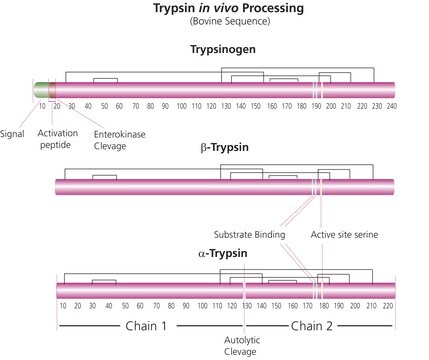Kluczowe dokumenty
T9128
Trypsin inhibitor
lyophilized powder, suitable for inhibition assay
Synonim(y):
SBTI
About This Item
Polecane produkty
product name
Trypsin inhibitor from Glycine max (soybean), lyophilized powder
pochodzenie biologiczne
Glycine max (soybean)
Poziom jakości
typ
Type II-S
Postać
lyophilized powder
masa cząsteczkowa
20,100 Da
metody
inhibition assay: suitable
rozpuszczalność
balanced salt solution: 1 mg/mL
concentrate: >10 mg/mL, hazy, amber-yellow
phosphate buffer: 10 mg/mL
water: 10 mg/mL
serum-free medium: soluble
Warunki transportu
ambient
temp. przechowywania
2-8°C
Szukasz podobnych produktów? Odwiedź Przewodnik dotyczący porównywania produktów
Działania biochem./fizjol.
Komponenty
Definicja jednostki
Uwaga dotycząca przygotowania
Solutions can retain activity when stored short-term at 2-8° C. Solutions are stable in frozen aliquots at -20°C.
Komentarz do analizy
Zastosowanie
Hasło ostrzegawcze
Danger
Zwroty wskazujące rodzaj zagrożenia
Zwroty wskazujące środki ostrożności
Klasyfikacja zagrożeń
Resp. Sens. 1 - Skin Sens. 1
Kod klasy składowania
11 - Combustible Solids
Klasa zagrożenia wodnego (WGK)
WGK 3
Temperatura zapłonu (°F)
Not applicable
Temperatura zapłonu (°C)
Not applicable
Środki ochrony indywidualnej
Eyeshields, Gloves, type N95 (US)
Certyfikaty analizy (CoA)
Poszukaj Certyfikaty analizy (CoA), wpisując numer partii/serii produktów. Numery serii i partii można znaleźć na etykiecie produktu po słowach „seria” lub „partia”.
Masz już ten produkt?
Dokumenty związane z niedawno zakupionymi produktami zostały zamieszczone w Bibliotece dokumentów.
Klienci oglądali również te produkty
Protokoły
Do pomiaru aktywności inhibitora trypsyny stosuje się spektrofotometryczny test oznaczania szybkości przy 253 nm. Jedna jednostka enzymu spowoduje zmianę absorbancji przy użyciu BAEE jako substratu.
Enzymatic Assay of Trypsin Inhibitor
Chromatograms
application for HPLCNasz zespół naukowców ma doświadczenie we wszystkich obszarach badań, w tym w naukach przyrodniczych, materiałoznawstwie, syntezie chemicznej, chromatografii, analityce i wielu innych dziedzinach.
Skontaktuj się z zespołem ds. pomocy technicznej

